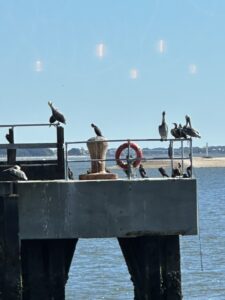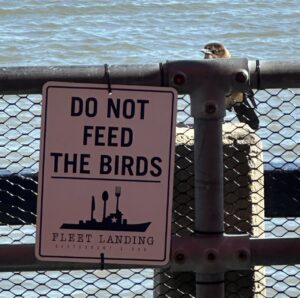Hello from Charleston, South Carolina!
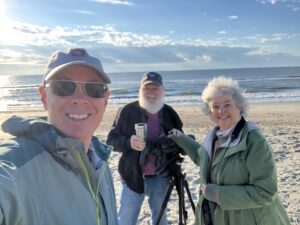
My favorite birding habitats have always been marshes, swamps, and seashores. And Charleston has all of these. The difficulty is accessing them. Of course, right now, with the federal government closed, federal areas are closed. Gates across access roads are shut and padlocked. But in Charleston and the surrounding areas, it is hard to find areas that are accessible at any time to the non-paying public. Places where you can easily park your car, throw your binoculars around your neck, your scope over your shoulder, and walk a reasonable distance – for us that would be no more than half a mile – set up and start watching birds. For me, too many places here are only open to people who are who are renting a near-by, upscale house, or to people on a local tour – many of these birding/wildlife/nature tours start at about $60/hour/person. Don’t get me wrong, tours can be wonderful – especially if you are new to an area. But Cleon and I like to be by ourselves. Quiet, solitude, surrounded by nature. Places in which to do that here are scarce. We are fortunate in that the house we all rented is three blocks from the beach and there is a public access – with parking. Most public beach accesses here have no parking. The tough part for us is most beaches around Charleston are lined with houses – gorgeous houses! But that means lots of early walkers with their dogs. Walkers, dogs, shorebirds – not a good mix.
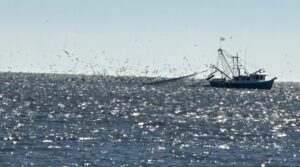
We have been on this beach close to where we are staying most mornings this week and the birds we are seeing remain the same and in about the same number. There is always at least one large fishing trawler offshore which attracts lots of birds. I am a bird lover, but I am not sure how I would feel working on one of these boats all day/every day. Maybe a cap that had an umbrella attached? There just has to be a whole lot of bird droppings raining down! Gulls and pelicans are great opportunists. They see a fishing boat and they are there!

Most of the gulls that are in and around the area are Laughing Gulls. We have seen a few Herring Gulls, Great Black-backed Gulls, and Ring-billed Gulls. We have also seen Forster’s Terns diving for fish in the Atlantic Ocean, the bays, and in the inlets. I have been looking for Northern Gannets, but so far, have seen none. We saw just one Sanderling at the water’s edge – normally where there is one Sanderling, there are several to many Sanderlings along with other shorebirds like the smaller sandpipers, willets, both Yellowlegs, Rudy Turnstones, and Black-bellied Plovers. But this stretch of
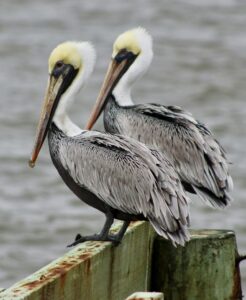
beach was full of walkers with their dogs. At the end of this paragraph, is the link to the video I shot. It was a windy day so you might want to turn your volume down. Watch the movements of this bird – they are often likened to ‘wind-up toys’. I think that is the perfect description! If you watch this short video to the end, you will see this bird really book it! Amazing! Sanderling
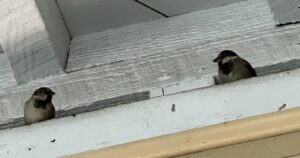
Never forget to look for birds everywhere you are. We spent time at the Charleston Market – all three of us had Christmas gifts to buy. And there – tucked up in the rafters – were House Sparrows.
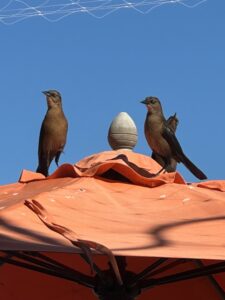
We ate lunch at a restaurant right on the water. And look who kept us company! Female Boat-tailed Grackles. There were males, but they were away from the restaurant and stayed close to the adjacent pier. Most of the time, in winter, female grackles will be together in one flock and males in another. Occasionally, you will see males and females together, but they tend to be more separate in fall and winter. I think female Boat-tailed Grackles are gorgeous birds – far more attractive than their males. I shot a video of males and females together at Kure Beach in NC last year. Turn your volume up as they are calling – I hesitate to use the word ‘singing’ as that would require a real stretch. Maybe the best way to describe it is that these birds are making noises. Here is the link: Boat-tailed Grackles
